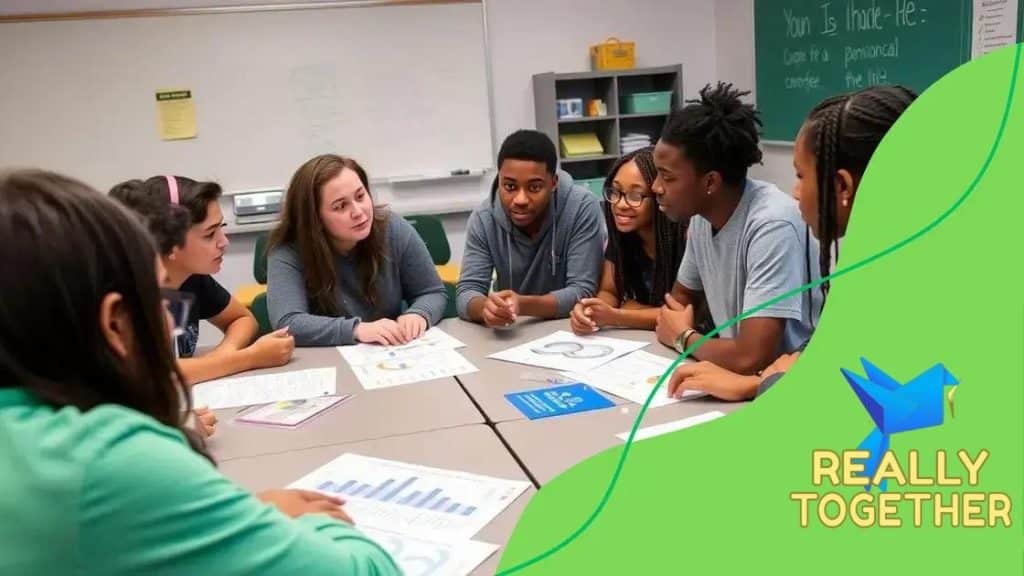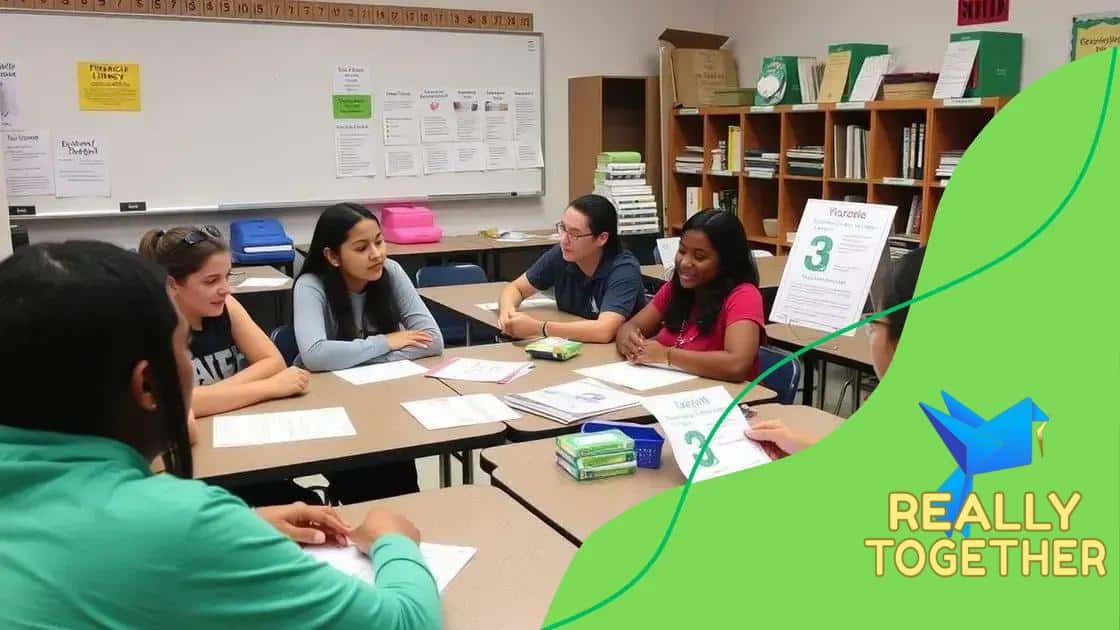Financial literacy education: Empowering your future

The importance of financial literacy education in high schools equips students with essential skills in budgeting, saving, and investing, preparing them for financial independence and responsible decision-making in adulthood.
The importance of financial literacy education in high schools cannot be overstated. It equips students with essential life skills, enabling them to make informed financial decisions as they step into adulthood.
Have you ever wondered how mastering budgeting or understanding credit could impact their future?
Understanding financial literacy: A foundational skill
Financial literacy education unlocks the skills to manage money like a superhero. High school students gain the power to make smart choices, setting the stage for a financially savvy adulthood.
From budgeting for daily expenses to understanding credit, these skills help students avoid financial traps. They learn to plan wisely, ensuring their money works as hard as they do.
Mastering these concepts early builds confidence for life’s big decisions. Whether it’s saving for college or dodging debt, financial literacy is the foundation for success.
Key components of financial literacy
There are several key components of financial literacy that students should understand:
- Budgeting: Learning how to create a budget helps students manage their income effectively.
- Saving: Understanding the importance of saving for emergencies and future goals.
- Investing: Exploring how investing can grow wealth over time.
By focusing on these components, financial literacy education encourages students to take control of their financial futures.
Moreover, mastering financial literacy prepares students for real-life scenarios such as managing credit cards and loans. Many may not realize that a strong grasp of these concepts could help them avoid significant debt and financial pitfalls later in life.
The role of schools in teaching financial literacy
Schools are pivotal in delivering financial literacy education, embedding money skills into students’ lives. By weaving these lessons into the curriculum, educators prepare teens for real-world challenges.
Workshops and classes bring concepts like budgeting and investing to life. These practical experiences ensure students are ready to manage their finances confidently.
Investing in this education isn’t just a perk, it’s a necessity. Schools that prioritize financial literacy empower students to thrive in an increasingly complex financial world.
Why financial literacy matters for high school students
Financial literacy education transforms high school students into confident, money-smart adults. It’s the key to unlocking a future free from financial stress and uncertainty.
By learning to budget, save, and invest, students prepare for life’s big moments, like college or their first apartment. These skills build a foundation for long-term success.
Without this knowledge, teens risk costly mistakes, like drowning in debt. Financial literacy equips them to make informed choices, fostering independence and stability.
Key reasons financial literacy is important
Financial literacy education drives smarter decisions, impacting long-term wealth. Students learn to evaluate options, from choosing bank accounts to avoiding predatory loans.
Understanding debt management prevents financial missteps, like racking up credit card balances. It teaches teens to use credit wisely, preserving their financial health.
Future planning, like saving for retirement or big purchases, becomes second nature. These skills empower students to dream big and achieve their goals confidently.
Real-Life applications of financial literacy
The importance of financial literacy stretches beyond the classroom. Students will use their financial skills in everyday situations, from grocery shopping to planning vacations. They become more aware of their spending habits and can better allocate their resources.
Moreover, financial literacy can have a positive impact on mental health. Avoiding financial stress leads to a more balanced and fulfilling life. As students develop these skills, they can better focus on their academic and personal growth.

Key topics to cover in financial literacy education
Financial literacy education thrives on teaching practical, impactful topics. From budgeting to investing, these lessons prepare students for real-world money challenges.
Budgeting helps teens track income and expenses, while saving strategies build a safety net for emergencies. These skills encourage thoughtful spending and financial discipline.
Investing basics and credit knowledge round out the curriculum, showing students how to grow wealth and avoid debt traps. These topics are essential for financial independence.
Essential topics in financial literacy
Key areas in financial literacy education include understanding credit, how scores, interest rates, and loans work. This knowledge prevents costly borrowing mistakes.
Saving strategies teach students to prioritize emergency funds and long-term goals. Meanwhile, investing basics reveal how to grow wealth through smart choices.
Setting financial goals motivates teens to plan for big dreams, like buying a car or funding college. These topics make money management exciting and achievable.
Real-world application
Every topic should connect back to real-life applications. For instance, when discussing how to manage debt, illustrate the consequences of high-interest loans and the best practices for repayment. When students see the relevance of these skills, they become more engaged in learning.
By covering these key topics in financial literacy education, we empower students with the knowledge they need to succeed financially. When they develop a solid foundation, they can confidently face the financial challenges of adulthood.
Real-life applications and benefits of financial skills
Financial literacy education shines in everyday scenarios, from grocery shopping to planning a dream trip. These skills make students savvy with their money.
Budgeting and saving help teens stretch their dollars, while investing knowledge sets them up for future wealth. These habits lead to smarter, stress-free decisions.
Mastering these skills boosts confidence and independence. Students who understand money management are ready to tackle adulthood with financial finesse.
Practical benefits of financial skills
Financial literacy education delivers tangible benefits, like budgeting to curb overspending. Teens learn to prioritize needs, making every dollar count.
Saving for emergencies or big goals builds security, while investing knowledge fuels wealth growth. These skills lay the groundwork for a prosperous future.
Debt management keeps students clear of financial traps, like high-interest loans. With these tools, they navigate life’s challenges with ease and assurance.
Impact on future success
Ultimately, mastering financial skills can significantly improve a student’s quality of life. Individuals who understand how to navigate financial issues tend to have less stress related to money matters.
These skills build a foundation for responsible financial behavior, leading to healthier financial habits well into adulthood. Students who can budget, save, and invest are likely to experience greater financial stability.
How schools can effectively teach financial literacy
Schools can make financial literacy education engaging by using hands-on, real-world methods. Interactive lessons turn abstract concepts into practical skills students can apply.
Simulations, like managing a mock budget or running a small business, spark interest. These activities show teens how money skills work in everyday life.
By fostering open discussions and using relatable examples, schools create a dynamic learning environment. This approach ensures students embrace financial literacy with enthusiasm.
Strategies for teaching financial literacy
Effective financial literacy education relies on real-life examples to make lessons relatable. Guest speakers, like financial advisors, inspire students with practical insights.
Technology, such as budgeting apps, makes learning interactive and fun. Group projects encourage collaboration, helping students apply money skills in team settings.
Partnering with local banks for workshops adds real-world context. These strategies ensure students are engaged and ready to master their financial futures.
Creating a financial literacy curriculum
Developing a comprehensive financial literacy curriculum is essential. Schools should outline clear learning objectives and gradually introduce complex concepts as students progress. By doing so, educators can ensure that all students achieve a solid foundation in financial literacy.
Furthermore, assessments should focus on practical applications of knowledge rather than rote memorization. This encourages students to think critically about their financial decisions.
In conclusion, financial literacy education in high schools is crucial for student success. By providing students with the tools to understand budgeting, saving, investing, and debt management, we prepare them for a more secure financial future.
Engaging teaching methods, practical applications, and real-life examples can make learning about money exciting and impactful. Schools, families, and communities must work together to ensure that the next generation is equipped with essential financial skills that will lead to responsible decision-making and independence in adulthood.
Financial literacy education in high schools is a game-changer for students’ futures. By teaching budgeting, saving, investing, and debt management, we equip teens with tools for success.
Engaging methods like simulations, guest speakers, and tech-driven lessons make learning impactful and fun. Schools, families, and communities must collaborate to ensure every student masters these skills, paving the way for confident, financially independent adults ready to conquer life’s challenges.
FAQ – Frequently Asked Questions about Financial Literacy Education in High Schools
Why is financial literacy important for high school students?
Financial literacy equips students with essential skills to make informed money decisions, helping them manage their finances as they transition to adulthood.
What are the key topics covered in financial literacy education?
Key topics include budgeting, saving, investing, and debt management, which are crucial for preparing students for real-life financial situations.
How can schools effectively teach financial literacy?
Schools can use hands-on activities, real-life examples, and technology to engage students and help them understand financial concepts clearly.
What are the benefits of mastering financial skills?
Mastering financial skills leads to better money management, greater financial independence, and reduced stress related to finances.





